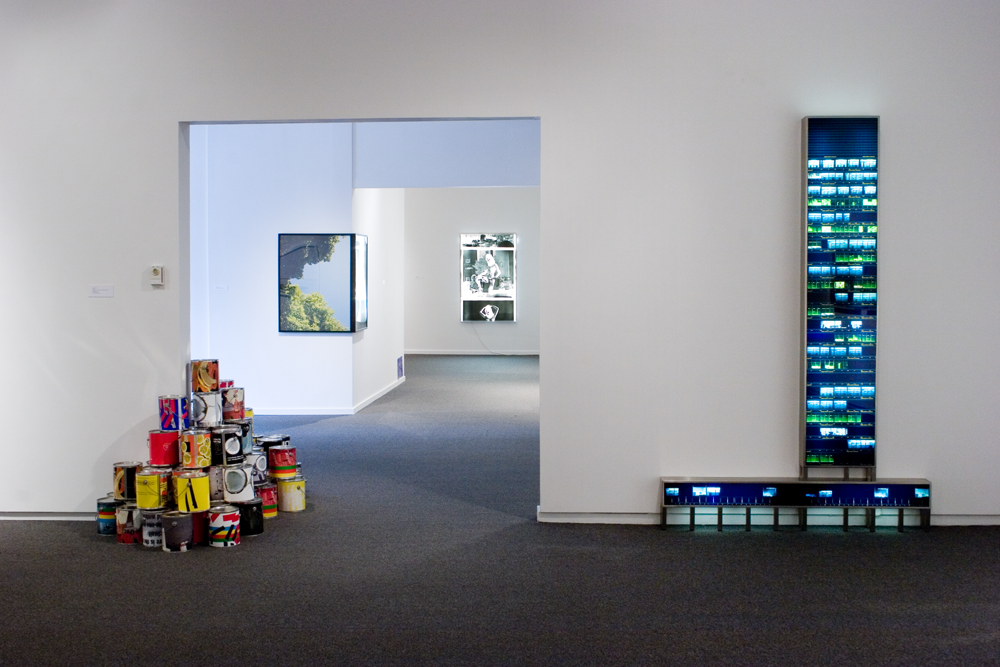Phot(o)bjects
Presentation House Gallery, Vancouver, Canada
Presentation House Gallery, Vancouver, Canada

Clear plastic bags filled with material were piled up near the entrance to the exhibition. A wall label confirmed that this was, in fact, an untitled art work (1989–2009) featuring shredded photographs by Sam Samore, not rubbish waiting to be collected; it was possible to imagine that, prior to their destruction, the pictures depicted sensitive information. Effectively linking both garbage and photography’s historical function as evidence, Samore’s work set the tone for this show of 20 artists – curated with wit and insight by Bob Nickas – that questioned commonly held assumptions about the medium. Pedantic theorizing, however, was avoided; unexpected moments of aesthetic surprise, including Samore’s non-trashy composition of sinuously intertwining and vibrant lines, abounded.
Like Samore’s work, Wolfgang Tillmans’ Lighter, green concave I (2007) features abstract photographic imagery encased in plastic. Harking back to conceptualist efforts to employ chance as a method of questioning professional standards of photographic competency, Tillmans exhibited a crumpled, sculptural object that would traditionally be rejected by a professional photographer. His decision to house and hang this ‘error’ in a protective Plexiglas box further encourages a reading of its indentations and diagonal creases as the features of a landscape, enhanced by its forest-green tones and the shadows provided by its folds. Far less conventionally pretty than Tillmans’ work, Rachel Harrison’s 7 of 9 (2002) is another predominantly abstract ‘phot(o)bject’ that fuses the pictorial with the sculptural. Consisting mostly of a plinth-like form placed in front of a wall, her work functions both as a display backdrop for a photograph and as a sculpture uncomfortable with its secondary status as background for an image; covered in a crude concoction of cement and rust-red paint, the plinth contains bulges, bits of wood and other rubble that compete with a relatively small and distorted photograph of a face featuring a single eye. The lack of definition suggests that the work’s two main components have been degraded or deformed to the extent that they do not comfortably cohere as either picture or sculpture. This sense of degradation is expressed further in Roe Ethridge’s Linda Anderson (Haunted House) (2004), a digital image of an apparitional house populated by gargoyles and ghosts created by the merging of pages of magazine advertisements.
Annette Kelm’s Herbert Tobias Record Covers (2007), a triptych of photocollages containing eclectic and fragmented images from old record covers also plays with ideas of photographic value; it’s unclear whether this musical or historical information has any archival purpose, or is the result of a chance selection – analogous to Tillmans’ deliberate embrace of printing and developing faults – or Ethridge’s merging of ads – associated with the whims of Tobias or Kelm.
B. Wurtz’s Untitled (container) (1988) features a comparable combination of remarkably humble subject matter and photographic imagery. In this case a three-dimensional, perforated metal cylinder was positioned on a short and lowly wooden pedestal, while in the background a photograph on the wall provided a view of the same cylinder that ostensibly staged this mundane, industrial-looking object as though it were a Modernist building façade seen from below. As with much of this imaginative show, Wurtz’s work plays wonderfully with the mythological power of photography to bestow importance – or even heavenly status, given the lofty clouds also featured in the picture – upon anything or anyone.
























